Live Bird Friendly
Birds are awesome, right? We encourage you to be a part of the solution for conservation for our feathered friends and live bird friendly! Check out these tips provided by our partners at Wild Birds Unlimited, or get more info on bird-friendly living in past articles we’ve written.
It’s Not Easy Being Feathered
The Rocky Mountains and Great Plains are wonderful for feeding and observing birds – more than 490 of North America’s 900-plus species have been sighted in Colorado alone. Our avian amigos face survival challenges just about every waking hour. To usurp Kermit the Frog’s slogan, “It’s not easy being feathered.” Fortunately, we can assist in birds’ survival and enhance our own enjoyment of backyard birding at the same time. Incorporating the four criteria essential for birds’ survival into our backyard habitats can increase the number of species we see and, in some small way, aid in their survival.
Create Bird-Friendly Habitat
Birds need suitable habitat that offers food, shelter, water and a place to nest.
Follow these tips below to welcome birds to your own yard.
1. Food

Your neighborhood ecology and migration patterns will help you decide on the appropriate feeders and food for your yard. Different birds forage at different heights and prefer different kinds of feeders (from platform to hopper to tube feeders) and diets (from seed to suet, nectar to fruit). Suet is a fat that many birds enjoy, especially in winter when food is scarce. You can:
- Smear suet on trees.
- Put suet on pine cones and hang them from tree branches.
- Recycle mesh bags to use as suet feeders.
- Make your own suet. Peanut butter is a great substitute for the animal fat used by commercial companies. You can fi nd a variety of easy recipes
on the Internet.
Keep in mind:
Change the feed regularly to keep it from becoming stale, sprouting or rotting. Clean your feeders once a month or so to reduce the possibility of spreading disease (hummingbird feeders should be cleaned at least once a week).
- Some food ideas: Black oil sunflower seed is a favorite of many birds (buying hulled seed will help prevent a mess on the ground).
- Finches and pine siskins like nyjer (niger) seed; jays, chickadees, titmice and woodpeckers go for peanuts.
- Ground-feeding birds such as doves, juncos and buntings like millet; use a low platform feeder just a few inches off the ground, and only put out as much seed as the birds will eat in a day.
- Be creative in feeding your birds: natural and unprocessed foods are the best – including berries and oranges, which orioles really enjoy.
Don’t forget to provide grit! Because birds don’t have teeth, grit is stored in their crops and used to grind food, which helps digestion. You may have seen a bird alongside a road collecting grit. An easy way to provide grit is to crush some egg shells (bake or boil to sanitize) into tiny pieces and place them next to your feeder.
2. Shelter

Design your bird sanctuary with places for birds to seek shelter. When you look at an aerial photograph of suburban and urban areas, what do you see? Houses and yards usually are what stand out. While one yard may be small, together, many houses with wildlife habitat have the potential to become a larger island or stepping stone of habitat getting a bird that much closer to the next patch of habitat. These patches can provide crucial resources to maintain healthy bird populations.
Offer a suitable place for birds to nest and raise young if you want to welcome the joy of babies into your yard. Backyard vegetation including trees, shrubs, and un-mowed grasses can serve this purpose well. See the following sections for incorporating natural habitat or artificial nest boxes into your space. Bird Conservancy of the Rockies encourages using native plants whenever possible.
3. Water
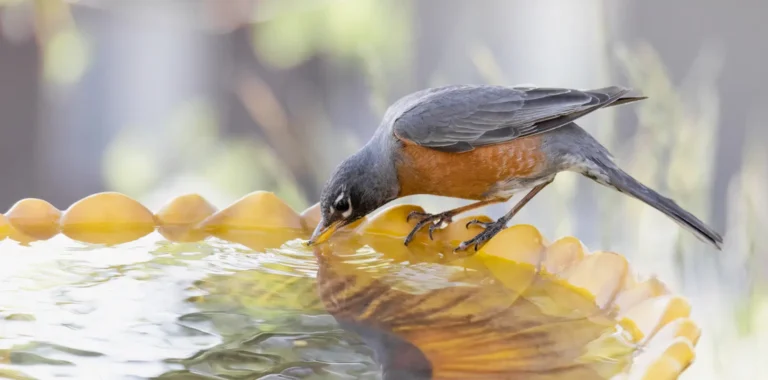
Water is second only to food in the number of species it attracts. It is especially important to have an open water source when all else is frozen. Birds will bathe in sub-freezing temperatures. (We think this is where the term bird-brain originated.) Actually, it is essential that they keep their feathers clean and fluffed, which enables them to more efficiently trap insulating air next to their bodies to keep warm. Open water also slakes their thirst while ingesting snow can be dehydrating. A bird bath filled with water on a winter day can stay open for quite some time. When considering what type of bird bath to provide, remember a few guidelines:
- Find one with edges that slope gradually, rather than with a deep lip.
- Find one with a rough-textured surface to provide better footing.
- Consider one that has tiers with recirculating water, and put gravel in one tier to provide a wading area.
- Or, make a recycled bird bath by reusing gallon jugs or other containers, or hang a shallow dish from a tree or an overhang.
- Place the bath within 15 to 20 feet of shelter or under a tree to provide birds with a quick getaway when predators appear.
- Replace water every other day for sanitary purposes and to prevent mosquitoes from laying eggs.
4. A place to nest
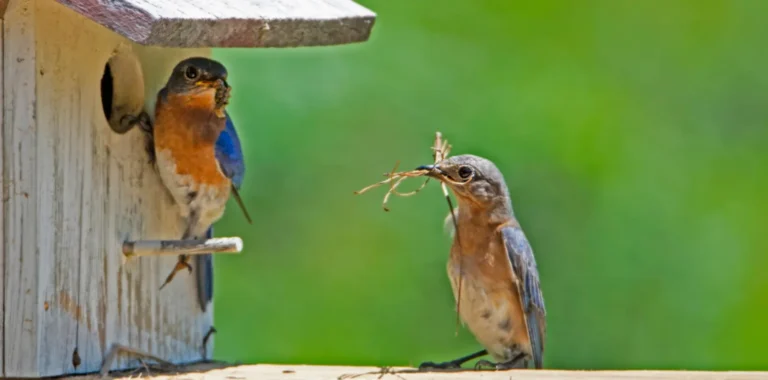
The final element birds are looking for is a suitable place to nest.
Backyard vegetation can serve this purpose well. With fewer wooden fence posts and our propensity to quickly remove dead trees, it is becoming harder for cavity-dwellers to find nesting sites. Nesting boxes or bird houses fill this niche. In selecting or building a house, we need to research the specific dimensions for the species we want to attract. It is amazing to see the birds out there with their little tape measures making certain the house fits their needs. The floor size, height of the entrance above the hole and the entrance hole size will determine who uses the house. Unfortunately, many birdhouses on the market are terrible for the survival of bird families.
When selecting a birdhouse, make certain it has good ventilation and good drainage, is made of non-toxic materials and finishes, and does not have a perch on the front. Predators love perches. Cavity-dwellers don’t need them. The house should be easy to clean out. Removing the old nest will help keep parasites out and help yield healthy feathered families.
Seven Simple Ways to Help Birds
Birds are in trouble, but YOU can help. Here are seven ways to make your home and lifestyle bird friendly.
1. Make Windows Safer, Day and Night
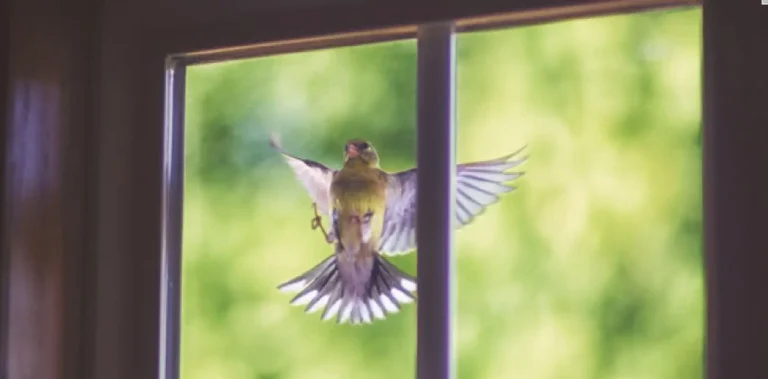
The challenge: Nearly 1 billion birds are estimated to die each year after hitting windows in the United States alone.
The cause: By day, birds perceive reflections in glass as habitat they can fly into. By night, migratory birds drawn in by city lights are at high risk of colliding with buildings.
Simple steps:
- Partially close blinds to produce visible horizontal lines
- On the outside of the window, install screens or break up reflections—using film, tape, string or products like Acopian BirdSavers, Feather Friendly or BirdSafe.
- Place feeders at appropriate locations – at least 30 feet away from windows, or very close (within 3 feet, so they cannot build enough momentum to injure themselves against the glass
Take it further: Work with small businesses or public buildings to offer a contest for creative “window mural” designs that make windows safer for birds. Advocate for bird-friendly building designs.
Get started today:
- Quick, affordable ways to keep birds from hitting windows
- Building or renovating a new office building? Check out the Bird-Friendly Building Design Manual
- Start a Lights Out Campaign in your community
2. Keep Cats Indoors

Cats present one of the biggest dangers to wild birds
Free-ranging felines kill between 2.5 and 4 billion birds every year in the United States. Except for habitat loss, cat predation is the greatest source of mortality for birds. Many bird species nest and feed on the ground, not in the trees, making them even more vulnerable. The bacteria in cat saliva are toxic to birds, so even if a cat does not immediately kill a bird, its bite often leads to infection and death. Cats are natural and effective predators and will hunt for practice and “fun”—even when not hungry.
How you can help
Bird Conservancy of the Rockies promotes keeping cats indoors at all times. This is the safest option for your pet, birds and people. The average life expectancy of a free-roaming cat is just 2 to 5 years, compared to 14 years for a cat who lives indoors. Unhealthy cats also pose direct health risks to people, such as the transmission of parasites and diseases like rabies and toxoplasmosis.
If you must let your cat outside and can’t keep an eye on it yourself, take the following precautions to minimize danger:
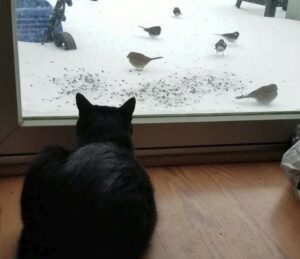 Shorten the amount of time spent outside. This reduces the amount of time your cat has to “play” with wildlife. Birds are most active at dusk and dawn, making them the most critical times to keep your cat inside.
Shorten the amount of time spent outside. This reduces the amount of time your cat has to “play” with wildlife. Birds are most active at dusk and dawn, making them the most critical times to keep your cat inside.- Trim your cat’s claws to make it harder to climb trees.
- Don’t feed stray cats. This encourages them to stay in your yard.
- Spay or neuter your cat. While this will not affect its hunting behavior, it will keep your cat from adding to cat populations.
- Keep your cat entertained with a windowed view of the outdoors where they can see the birds but not catch them. A secured screen porch works well, or consider a catio or similar enclosure.
- Go shopping! You can find a number of different products, such as colorful cat collars, cat bibs and pens to keep cats contained, that claim to lessen the ability of your cat to catch wildlife.
- Spread the word to friends, family and neighbors about why keeping all cats indoors is the right thing to do.
Managing feral cats
Feral (“wild”) cats present special challenges as they often cannot be tamed and rehabilitated for indoor life. There are an estimated 60 million feral cats in the U.S. Each year, hundreds of thousands of cats are euthanized by humane societies and animal shelters because there are not enough homes for them, regardless of demeanor. Catch-and-release programs, where feral cats are spayed/neutered and then set free again, are intended as a humane way to control cat populations. While compassionate and with the best intentions, the approach is flawed and fails to reduce cat numbers. This is especially the case with “managed” colonies where people regularly provide food. Research shows these colonies often increase in size, as more cats are attracted to the food (and other felines) and unsterilized animals continue to breed. Meanwhile, the cats are free to continue hunting local wildlife for many years.
Additional information
Further reading
- Why Curtailing Your Cat Is for the Birds (National Wildlife Federation)
- The Moral Cost of Cats (Smithsonian)
- The Impact of Free-ranging Domestic Cats on Wildlife (Nature Communications)
- Impacts of Feral and Free-Ranging Cats on Bird Species of Conservation Concern (American Bird Conservancy)
- The Cat’s Meow: Catios Provide Perfect Spot (U.S. Humane Society)
3. Reduce Lawn, Plant Natives
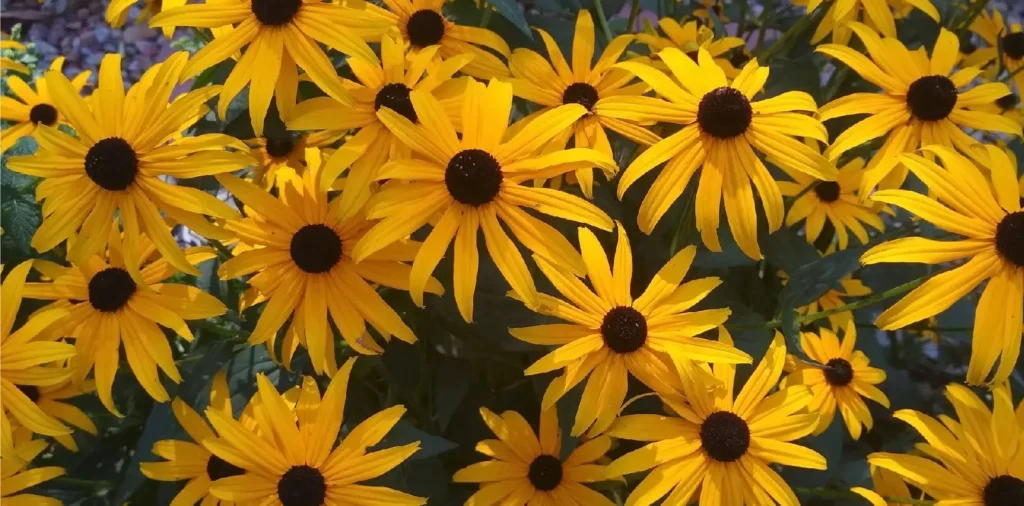
Birds have fewer places to safely rest during migration and to raise their young: More than 10 million acres of land in the United States were converted to developed land from 1982 to 1997.
The cause: Lawns and pavement don’t offer enough food or shelter for many birds and other wildlife. With more than 63 million acres of lawn in the United States alone, there’s huge potential to support wildlife by replacing lawns with native plantings.
Take it further: Add native plants and watch birds come in. Native plants add interest and beauty to your yard and neighborhood and provide shelter and nesting areas for birds. The nectar, seeds, berries and insects will sustain birds and diverse wildlife.
Get started today:
- Find out which native plants are best for your area
- Live in Colorado’s Front Range? Check out the Guide to Backyard Birds of the Front Range!
- Certify your backyard as a Backyard Wildlife Habitat or become a Habitat Hero
4. Avoid Pesticides

The challenge: More than 1 billion pounds of pesticides are applied in the United States each year. The nation’s most widely used insecticides, called neonicotinoids or “neonics,” are lethal to birds and to the insects that birds consume. Common weed killers used around homes, such as 2, 4-D and glyphosate (used in Roundup), can be toxic to wildlife, and glyphosate has been declared a probable human carcinogen.
The cause: Pesticides that are toxic to birds can harm them directly through contact, or if they eat contaminated seeds or prey. Pesticides can also harm birds indirectly by reducing the number of insects that birds need to survive.
A healthy choice for you, your family and birds: Consider purchasing organic food. Nearly 70% of produce sold in the United States contains pesticides. Reduce pesticides around your home.
Take it further: Avoid using neonicotinoids around your home, garden and in your community. Make your voice heard with elected officials and share your opinions about legislation to regulate the use of neonics.
Get started today:
- Check out the Shopper’s Guide to Pesticides in Produce
- Take the Pollinator Pledge to protect birds and bees from harmful pesticides
5. Drink Bird-Friendly Coffee

The challenge: Three-quarters of the world’s coffee farms grow their plants in the sun, destroying forests that birds and other wildlife need for food and shelter. Sun-grown coffee also often requires using environmentally harmful pesticides and fertilizers. On the other hand, farms that grow coffee in the shade of native trees preserve a forest canopy that helps migratory birds survive the winter.
The cause: Too few consumers are aware of the problems of sun coffee. Those who are aware may be reluctant to pay more for environmentally sustainable coffee.
Insist on Bird-Friendly Coffee: Bird-Friendly Coffee is a certification from the Smithsonian Migratory Bird Center that also includes organic and fair trade standards. Buying Bird-Friendly coffee is a win-win-win: it’s delicious, economically beneficial to coffee farmers, and helps more than 42 species of North American migratory songbirds that winter in coffee plantations, including orioles, warblers, and thrushes. It’s important to note that Bird-Friendly is a specific certification, while “shade-grown” is not. “Shade-grown” coffee can range from fully sustainable and organic to nearly indistinguishable from sun-grown coffee. Find more information from All About Birds.
Take it further: Educate your local coffee shops and grocery stores about how Bird-Friendly coffee helps birds and the environment.
Get started today:
- Look for the Smithsonian-certified Bird-Friendly coffee seal of approval
- Set up a coffee subscription with Birds & Beans (they have great tasting coffee!)
- Read this article about why we and other organizations support Bird-Friendly Coffee
6. Protect Our Planet from Plastics

The challenge: It’s estimated that 4,900 million metric tons of plastic have accumulated in landfills and in our environment worldwide, polluting our oceans and harming wildlife such as seabirds, whales and turtles that mistakenly eat plastic, or become entangled in it.
The cause: Plastic takes more than 400 years to degrade, and 91% of plastics created are not recycled. Studies show that at least 80 seabird species ingest plastic, mistaking it for food. Cigarette lighters, toothbrushes and other trash have been found in the stomachs of dead albatrosses.
Reduce your use of plastics: Avoid single-use plastics including bags, bottles, wraps and disposable utensils. It’s far better to choose reusable items, but if you do have disposable plastic, be sure to recycle it.
Take it further: Lead by example and reduce your use of plastic bags, styrofoam, straws and single-use plastics. Encourage stores to offer incentives for reusable bags, and ask restaurants and other businesses to phase out single-use plastics.
Get started today:
7. Watch Birds, Share What You See

The challenge: The world’s most abundant bird, the Passenger Pigeon, went extinct, and people didn’t realize how quickly it was vanishing until it was too late. Monitoring birds is essential to help protect them, but tracking the health of the world’s 10,000 bird species is an immense challenge.
The cause: To understand how birds are faring, scientists need hundreds of thousands of people to report what they’re seeing in backyards, neighborhoods and wild places around the world. Without this information, scientists will not have enough timely data to show where and when birds are declining around the world.
Enjoy birds while helping science and conservation: Join a project such as eBird, iNaturalist, Project FeederWatch, a Christmas Bird Count or a Breeding Bird Survey to record your bird observations. Your contributions provide valuable information to show where birds are thriving—and where they need our help.
Take it further: Mobilize others in your community by organizing school groups or leading bird walks and submitting your counts to eBird.org. Support organizations that coordinate bird-monitoring projects in your area.
Get started today:
Gardening for Birds
The Front Range consists of an area that rises thousands of feet in elevation. As you go up in elevation, the vegetation changes. At lower elevations along the Front Range, you typically find grasslands. As the elevation increases, you find more shrublands, eventually transitioning to coniferous forests at higher elevations. Interspersed within these plant communities are wetlands, or areas around rivers, lakes and streams, with their own vegetation types. By providing suitable plant communities in your yard, you provide important habitat for different birds, so knowing the ecosystem in which you live will help you know what bird species you can hope to attract. Click on the different habitats below to learn how you get started creating a native plant sanctuary in your own yard!
Grassland Demonstration Garden
Grasslands along the Front Range consist largely of short-stature grasses, including blue grama and buffalo grass. While much of the shortgrass prairie along the Front Range has been converted to agricultural and urban areas within the last century, pockets of native prairie can still be found on the eastern edge of the Front Range. Trees are rarely found within this plant community, except for wetter areas where the plains cottonwood thrives, providing important habitat for birds and other wildlife. In general, this ecosystem is highly drought resistant and can exist up to elevations of 6,000 feet. Below is a list of plants currently planted in the Grassland demonstration garden at the Environmental Learning Center.
Native Plant List (Note: always refer to scientific names (in italics) when referencing plants)
blue grama grass (Bouteloua gracilis)
blaze little bluestem grass (Schizachyrium scoparium ‘Blaze’)
mintleaf bergamot (Monarda fistulosa var. menthifolia)
colorado four o’clock (Mirabilis multiflora)
upright prairie coneflower (Ratibida columnifera)
soapweed yucca (Yucca glauca)
Rocky Mountain Penstemon (Penstemon strictus Benth.)
Montane/Forest Demonstration Garden
This ecosystem is composed of two different communities. The first is pinyon-juniper woodlands that can exist from 4,900 to 8,000 feet. The pinyon-juniper woodlands are dominated by pinyon pine and/or juniper, and occur in a limited distribution along the south end of the Front Range. Trees are relatively short (usually less than 20 feet tall) and are often mixed with other plant communities including shrublands and grasslands. The second community are ponderosa pine woodlands that can exist from 6,000 to 8,000 feet. Ponderosa pine trees are drought resistant. This ecosystem can have understory plants (shrubs and grasses) that add to the bird diversity found here. Below is a list of plants currently planted in the Montane/Forest demonstration garden at the Environmental Learning Center.
Native Plant List (Note: always refer to scientific names (in italics) when referencing plants)
pinyon pine (Pinus edulis)
woodland strawberry (Fragaria vesca americana)
lanceleaf tickseed (Coreopsis lanceolata)
wax currant (Ribes cereum)
Old man’s whiskers (Geum triflorum)
sticky purple geranium (Geranium viscosissimum)
American plum (Prunus americana)
Shrubland Demonstration Garden
Shrublands vary in density and may include Gambel oak, mountain mahogany, skunkbush sumac, and antelope bitterbrush. Some shrubs, such as black chokecherry, can grow quite large. Shrublands are sometimes interspersed with trees or patches of grass. This plant community can exist at elevations from 5,000 to 9,500 feet. Below is a list of plants currently planted in the Shrubland demonstration garden at the Environmental Learning Center.
Native Plant List (Note: always refer to scientific names (in italics) when referencing plants)
Gambel Oak (Quercus gambelii)
alderleaf mountain mahogany (Cercocarpus montanus)
skunkbush sumac (Rhus trilobata)
western sandcherry (Prunus pumila var. besseyi)
butterfly milkweed (Asclepias tuberosa)
golden currant (Ribes aureum)
blanketflower (Gaillardia aristata)
Wetland Demonstration Garden
Wetlands are areas along rivers, lakes, and streams. This plant community has the highest plant and animal diversity among ecosystems along the Front Range because of the presence of water. Wetlands can vary from marshes (always flooded) with cattails and bulrushes, to wet meadows (periodically flooded) with low grasses and sedges, to flowing streams, rivers, and ponds, each with differing types of vegetation including plains cottonwood, American plum, snowberry, and willow species. This ecosystem can exist at all elevations along the Front Range. Below is a list of plants currently planted in the Wetland demonstration garden at the Environmental Learning Center.
Native Plant List (Note: always refer to scientific names (in italics) when referencing plants)
common snowberry (Symphoricarpos albus)
common sneezeweed (Helenium autumnale)
Colorado blue columbine (Aquilegia caerulea)
beach-head iris (Iris hookeri)
plains cottonwood (Populus deltoides)
More Information
Click the following links for more information about ways to create a wildlife friendly yard:
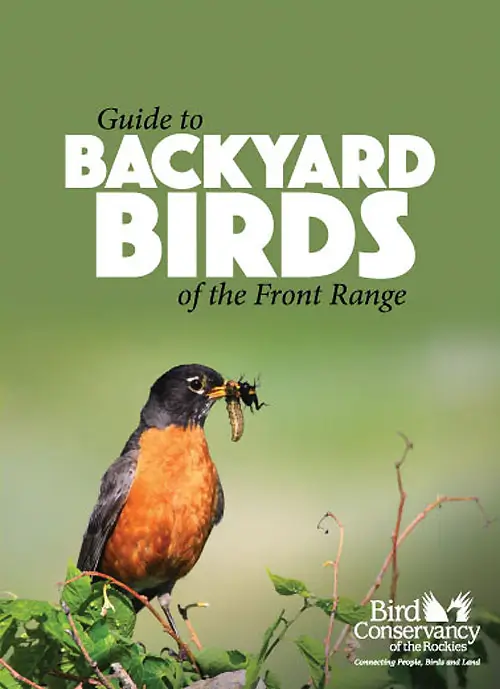
Guide to the Backyard Birds of the Front Range
Bird Conservancy of the Rockies invites you to share the joy of birds and birdwatching with our Guide To Backyard Birds of the Front Range!
Use it as a field guide while out enjoying local open spaces, natural areas, parks and backyards. Take it with you to the local nursery to stock up on bird-friendly native plants and be sure to stop by your local bird feeder and seed store too. Few handy resources provide a comprehensive plan for making backyards an oasis for birds.
“The Guide’s high-quality photographs and
simple descriptions will help any bird lover
identify what they see, or wish to see, in
their backyard or elsewhere.”
-Alison Holloran, Executive Director
Audubon Rockies
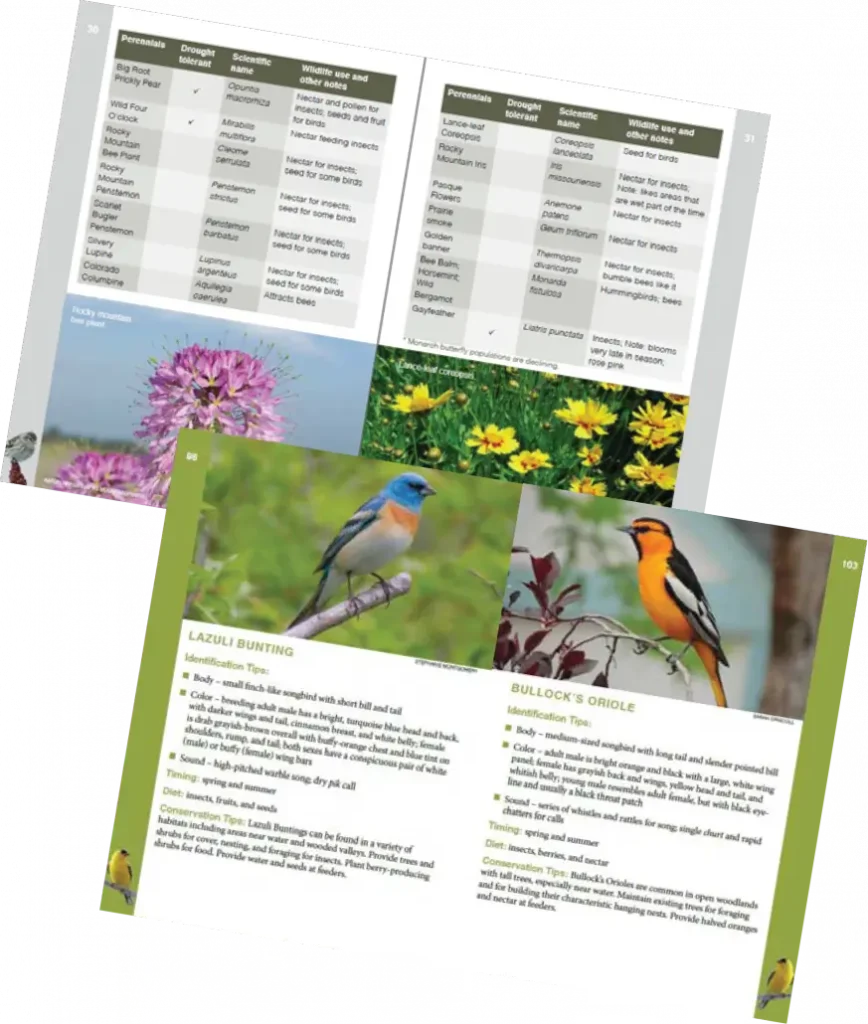
The Guide is available online in Spanish & English as a FREE download by clicking the links below:
The first edition of the Guide to Backyard Birds is out of print. Look for a new Guide to Urban Birds in 2025!
To obtain your very own personal copy of Guide to Backyard Birds of the Front Range, try your local Wild Birds Unlimited store in Denver, Arvada or Fort Collins.
The Guide to Backyard Birds of the Front Range is made possible through the generous support of our sponsors

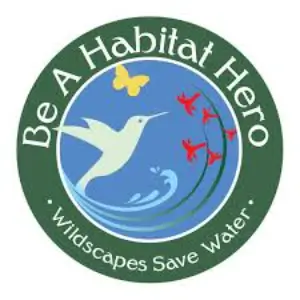

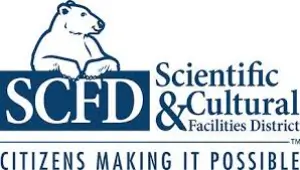

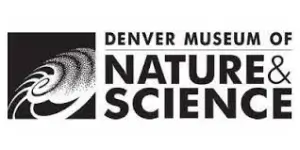

*The 1st edition printing of Guide to Backyard Birds of the Front Range included two small errors.







